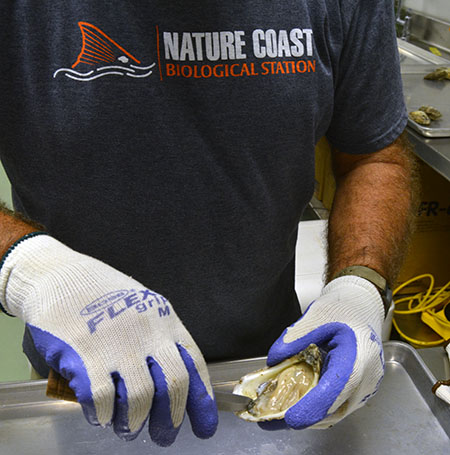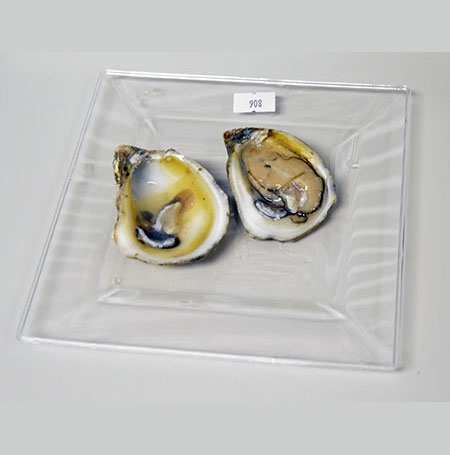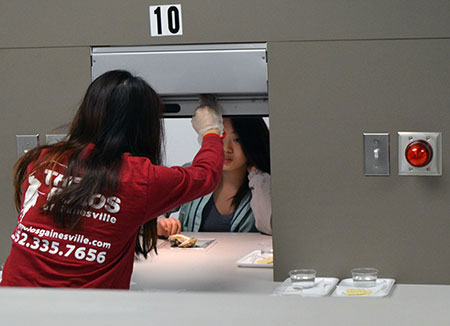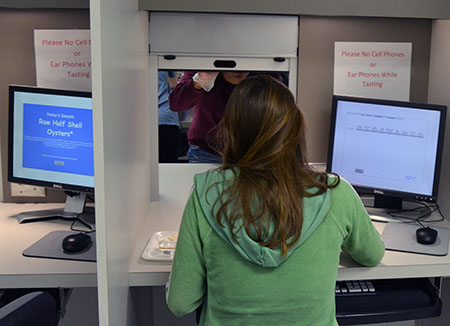Oysters typically acquire their flavor from their growing environment and are frequently named after their harvest location. Consumers can expect variations in appearance, color, aroma, taste, and mouth-feel that influence preferences, value, and reputation. Sensory attributes and acceptability can make the difference in market success of Florida cultured oysters. Diploid and triploid oysters harvested from the UF demonstration site in Cedar Key were delivered under refrigerated conditions to the UF/IFAS Food Science and Human Nutrition Department in Gainesville on May 24, 2017 for evaluation under the guidance of Dr. Charles Sims. All rules pertaining to harvesting and handling of oysters, including tagging, time/temperature matrix and refrigerated storage, as outlined in the FDACS Comprehensive Shellfish Control Code (Chapter 5L-1, F.A.C.), were followed. Triploid oysters averaged 81 mm (3.2”) in shell height and 120 grams in total weight, while the diploids averaged 76 mm (3.0”) and 74 grams. Although the two oyster types were similar in size, the triploids were obviously heavier than the diploids.
The oyster samples were subjected to consumer evaluation for acceptability. Panelists (n=75) were recruited to participate in the sensory evaluation; all indicated in a pre-screening test that they were consumers of raw oysters. Panelists were primarily students, faculty, and staff from UF. Oysters were shucked and two oysters from each ploidy type were provided to panelists in individual booths. The oyster samples were presented on trays and coded with three-digit random numbers. Panelists rated appearance, texture, flavor, and overall acceptability on a 9-point hedonic scale (1=dislike extremely, 5=neither like nor dislike, 9=like extremely). Data was subjected to statistical analysis to determine significance of results. The triploid oysters rated higher in overall acceptability and appearance than the diploid oysters (P=0.10). There were no statistical differences in flavor and texture between the two oyster samples. Likewise, there was no difference between the two samples for preference. However, there was a trend that the triploid oysters were favored as the averages for all attributes were higher than those for the diploid oysters.
In addition, the oyster meats were analyzed for microbial consequences. Microbial measures were based on standard aerobic plate counts utilizing U.S. Food and Drug Administration (FDA) analytical procedures for seafood. Aerobic plate count (APC) indicates the level of microorganisms in a product. APC on fish and fishery products generally do not relate to food safety hazards, but sometimes can be useful to indicate quality, shelf life, and contamination. Counts were 600 and 1,200 per gram for the triploid and diploid oyster samples, respectively. These counts were low and below levels recommended for safe shellfish by Florida and other states (maximum 500,000 cfu/gram).
As part of the demonstration project, another crop of oysters is anticipated to be harvested in the fall. Samples of diploid and triploid oysters will be evaluated then to determine seasonal differences in acceptability and sensory attributes.







